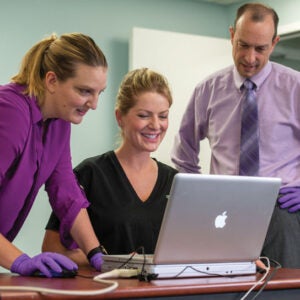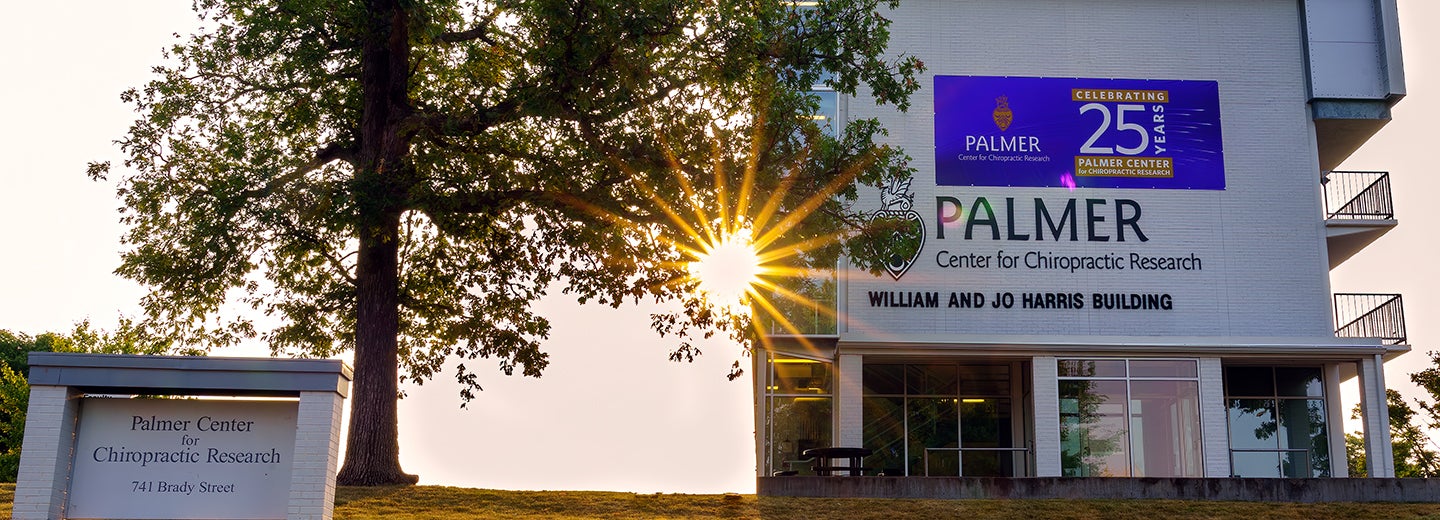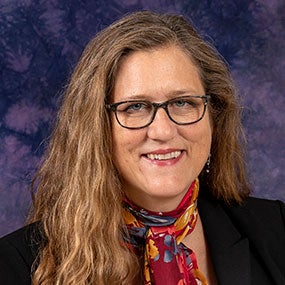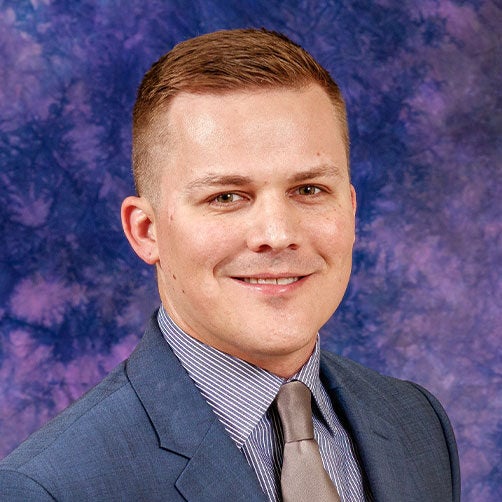 In the southeast corner of Palmer College of Chiropractic’s Main Campus in Davenport, an unassuming white brick building stands shielded by oak trees. You would be forgiven if you walked past the William and Jo Harris Building not realizing it contains the Palmer Center for Chiropractic Research (PCCR), the most well-funded chiropractic research center in the U.S.
In the southeast corner of Palmer College of Chiropractic’s Main Campus in Davenport, an unassuming white brick building stands shielded by oak trees. You would be forgiven if you walked past the William and Jo Harris Building not realizing it contains the Palmer Center for Chiropractic Research (PCCR), the most well-funded chiropractic research center in the U.S.
PCCR was founded nearly 30 years ago to promote research that would advance chiropractic education and practice. It has done exactly that. Every day, PCCR researchers are working to advance the chiropractic profession and keep Palmer College at the leading edge by generating new knowledge available to students and Doctors of Chiropractic.
Research Transforms Patient Outcomes and Builds Paths for Chiropractic
At the helm of PCCR is Cynthia Long, Ph.D., PStat, dean of research, who was recently recognized as the most highly-published and collaborative researcher in manual therapy for low-back pain over the past two decades.
“No other chiropractic college has anything resembling Palmer Center for Chiropractic Research,” she notes. “In terms of resources, reputation, publications and our team of brilliant researchers, Palmer stands alone. PCCR is known as a place where curious people are working together and making a real difference in the lives of patients by advancing what we know about chiropractic.”
Though not a chiropractor herself, Dr. Long has worked at PCCR since it was founded in 1995. At the time, she was just finishing her doctorate in biostatistics and in search of a home to begin her career. “We’re backed by a College and alumni network that believe in the importance of research. That support provides the stability required for driven researchers to pursue complex questions, complete long-term projects and push the field forward.”
Palmer’s research center has been continuously funded by National Institutes of Health (NIH) grants since 1997. Along with those research grants, Palmer invests up to another $3 million in PCCR each year. The College’s commitment to research is reflected in its mission: to promote learning, deliver health care, engage communities and advance knowledge through research.
While Palmer students have opportunities to engage with PCCR while on campus, only a small number go on to pursue research as a career. So, what exactly is chiropractic research? And why is Palmer all-in on its research center?
“Ultimately, this work is about improving patient care — it is the impact on the patient that guides our vision,” says Dr. Long. “We do that by producing new knowledge that influences practice in the clinic, pedagogy in the classroom and our ability to speak to peers in other fields.”
Every researcher at PCCR has a specialty and a unique research agenda. Recent publications have reported on research visualizing connective tissues over a course of care for people with chronic low back pain, using insurance claims to investigate predictors of escalated spine care, describing characteristics of patients in VA chiropractic clinics during the COVID-19 pandemic, and touched on more than 25 other topics in the last fiscal period alone.
This growing body of knowledge does not appear overnight. For Dr. Long and the team of Palmer researchers, the time between an idea and a published paper can be years. “Some of our larger-scale trials can take five to 10 years,” says Zacariah Shannon, D.C., M.S., Ph.D., assistant professor, PCCR (’14). “And some questions can linger, guiding an entire career of research. Every researcher seems to have that type of curiosity.”
Curiosity, Collaboration and Creating Tools for Better Outcomes
After graduating from Palmer, Dr. Shannon worked in a clinical setting before that curiosity drew him to PCCR. “While I was practicing, I kept looking for answers, but it felt like there was a lot of missing information,” says Dr. Shannon. “I wanted to be part of the effort to answer those questions. At the PCCR I found an environment that rewards asking questions. The support here has helped me grow as a researcher.”
Dr. Shannon speaks from his PCCR office; his wall is filled with diplomas, his desk with spreadsheets and articles waiting to be read. “Research doesn’t end,” he laughs. “You publish an article, but you’ve already got another project in the trial stage.”
Dr. Shannon’s determination and drive for answers have already been rewarded. Last year, he won the Early Research Career Research Award at the World Federation of Chiropractic Biennial Congress.
The award recognized Dr. Shannon’s paper reviewing the impact of chiropractic care on military personnel. “It meant a lot to have the work recognized,” says Dr. Shannon. “I depended on data from a previous Palmer trial, so it is another example of how we are building a body of knowledge — no work in research is truly individual.”
Collaboration has been essential to the growth and success of Palmer’s research center. This means collaboration between researchers as well as between institutions. PCCR was the driving force behind the creation of the Inter-Institutional Network for Chiropractic Research, which also includes Yale University Section of Biomedical Informatics and Data Science and the Osher Center for Integrative Health (jointly based at Harvard Medical School and Brigham and Women’s Hospital).
“It’s hard for me to think of good research being conducted by a single person,” says Robert Vining, D.C., D.H.Sc., associate dean of clinical research. “Our partnering institutions are extremely important. Those collaborations allow us to participate in research conducted by our collaborators at other institutions and access researchers with different experiences and areas of expertise that are complementary to our own.”
Dr. Vining’s research has a focus on translation or practical implementation. This means that one of his goals is to create tools and knowledge that are accessible and helpful to providers. “There isn’t much point in learning something through scientific research if you’re not able to share it with others,” he says.
Some research can yield niche information that is difficult to interpret.
Dr. Vining, for example, has been engaged in work designed to use clinical guidelines, best practices, and care standards to develop ways of measuring key components of chiropractic care for the ultimate benefit of patients. In early 2024, Dr. Vining’s two-year project to develop quality indicators for chiropractic care was published, and it’s already informing practice on campus.
“Health care has thousands of standardized, evidence-based measures of quality that assess and guide care and inform quality improvement processes,” Dr. Vining explains. “But until now, chiropractic did not have a common set of quality indicators. We transformed evidence from current clinical guidelines, care standards, and best practices into 70 preliminary quality indicators which are now beginning to be implemented and further studied here at the College.” In time, Dr. Vining anticipates the indicators will be refined and provide new ways to assess and promote quality care. This line of research offers the potential to assess chiropractic care consistent with how quality is assessed among other health disciplines.
Students Help Shape Chiropractic Research
The PCCR is interested in fostering research experiences by providing current students with opportunities to be involved in research projects. PCCR’s Research Honors Program allows students to engage even more closely with the research process.
“The program allows students to see what research really looks like,” says Dr. Long. “They can get involved for just a trimester, or they can dive in and end up as a co-author on a publication. Increasingly, students are coming to Palmer from undergraduate campuses where research was common. Giving them access to research experience and mentorship is important for the College.”
Palmer Florida student, Alexis Hannah is one of three students who is participating in an NIH-funded research project titled “Spinal Manipulative Therapy vs. Prescription Drug Therapy for Care of Aged Medicare Beneficiaries with Neck Pain.” Led by faculty mentor Brian Anderson, D.C., M.P.H., M.S., Ph.D., Palmer students are collaborating with peers at Southern California University of Health Sciences and getting first-hand experience with research.
“The program has already been very formative for me,” says Alexis. “The opportunity to work closely with faculty, to collaborate with students at other institutions and to see what research really looks like has been a great experience. I’ve gained confidence and a new perspective that’s informing the rest of my studies.”
Most Research Honors Program students go on to work in a clinical setting, but Dr. Long believes the lessons and experience gained at the PCCR benefit them wherever they go. “The experience makes our students very competitive candidates for opportunities such as a Veterans Affairs residency and as clinicians in integrative health care environments. And for those who go into private practice, they have a valuable perspective — curious people are always going to flourish.”
Like any space on the Palmer campus, in the PCCR, a visitor is likely to find a gathering of those curious people.
“There is always something happening here,” says Dr. Vining. “Sometimes it’s quiet, but that belies the intensity. We are always communicating and collaborating with colleagues here in the building or across the country. It’s a building full of curious — maybe even a little bit skeptical — people and we are always pushing ideas forward.”
Looking Into the Future
As PCCR approaches its 30th year, the faculty have an eye on the future. You might expect that future to include big shifts in thinking or a technological breakthrough, but PCCR is more focused on people and relationships.
“When I think about the future, I see an even greater degree of collaboration,” says Dr. Shannon. “Doing good research requires having the right partners. People are noticing the work happening at PCCR, and I think there will be more opportunities to expand our network and produce knowledge that helps patients live better lives.”
Thanks to its focus on science and collaboration, the future is already unfolding. “The next 30 years is going to depend on relationships,” says Dr. Long. “Good research usually requires some advanced or specialized tools and technology, but the most important element is people. It’s finding the right people, supporting them and letting them work together to answer the questions that matter most to our field.”
The World Health Organization Recognizes Spinal Manipulation In New Lower-Back Pain Guideline
The World Health Organization (WHO) has developed a guideline for proper management of chronic low-back pain (LBP) for the first time ever. Among the approved interventions, WHO recognizes spinal manipulative therapy as effective in the care of adults, including older people, with chronic primary LBP.
Globally, LBP is the leading cause of disability, impacting 619 million people. That number has gone up 60% since 1990. According to the WHO, “cases of LBP are expected to rise to an estimated 843 million by 2050, with the greatest growth anticipated in Africa and Asia, where populations are getting larger, and people are living longer.”
The WHO states that people around the world deserve “holistic, person-centered, equitable, non-stigmatizing, non-discriminatory, integrated and coordinated” care. This newly developed guideline provides evidence-based direction for providers and indicates that spinal manipulative therapy can be a valuable and effective part of a patient’s care.
The new guideline was coordinated by the Ageing and Health Unit, with further guidance from an independent methodologist. Guideline development relies on the findings of hundreds of research trials and publications, just like those being produced by the Palmer Center for Chiropractic Research.

 In the southeast corner of Palmer College of Chiropractic’s Main Campus in Davenport, an unassuming white brick building stands shielded by oak trees. You would be forgiven if you walked past the William and Jo Harris Building not realizing it contains the Palmer Center for Chiropractic Research (PCCR), the most well-funded chiropractic research center in the U.S.
In the southeast corner of Palmer College of Chiropractic’s Main Campus in Davenport, an unassuming white brick building stands shielded by oak trees. You would be forgiven if you walked past the William and Jo Harris Building not realizing it contains the Palmer Center for Chiropractic Research (PCCR), the most well-funded chiropractic research center in the U.S.



